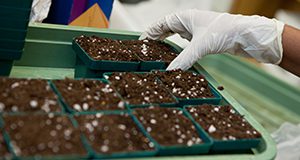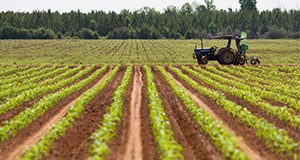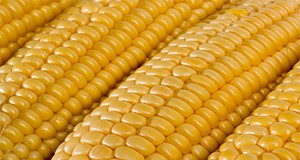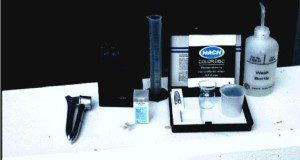A medida que los productores y consultores comienzan a usar la tecnología de monitoreo de savia, surgen preguntas sobre los procedimientos del monitoreo de savia. Las siguientes guías deberían ayudar a las personas que actualmente usan o están interesadas en usar el monitoreo de savia. La mayoría de estas guías se han desarrollado a través de investigaciones en Florida, o se basan en la experiencia de campo.
This is the Spanish translation of CIR1144/CV004, Plant Petiole Sap-Testing For Vegetable Crops. Written by George Hochmuth, translated by Maria Paz Kinslow, and published by the UF/IFAS Horticultural Sciences Department.
https://edis.ifas.ufl.edu/hs1368
Tag: George Hochmuth
UF/IFAS Standardized Nutrient Recommendations for Vegetable Crop Production in Florida
Soil testing is a scientific tool for effective nutrient management that provides an estimate or an index of the available nutrient-supplying capacity of the soil. This 9-page publication presents the fertilization recommendations for vegetable crops based on soil tests performed by the IFAS Extension Soil Testing Laboratory (ESTL). Written by Rao Mylavarapu, George Hochmuth, and Guodong Liu and published by the UF/IFAS Department of Soil and Water Sciences, December 2017.
http://edis.ifas.ufl.edu/cv002
Agricultural Soils of Florida

This seven-page fact sheet describes the various soil Orders in Florida, how they were developed, their characteristics, coverage in the state, and uses. This information is important for educating land owners, decision-makers, and educators about soils in Florida, leading to better soil management for agricultural and environmental sustainability. Written by Rao Mylavarapu, Willie Harris, and George Hochmuth and published by the Soil and Water Sciences Department.
http://edis.ifas.ufl.edu/ss655
Lowering Soil pH to Optimize Nutrient Management and Crop Production

Because temperatures are relatively high and it rains a lot in the region, mineral soils in the southeastern United States tend to be naturally acidic. Managing soils for both pH and nutrients helps maintain soil fertility levels and ensure economic agricultural production. If they are not maintained in the 6.0 to 6.5 pH range, which is best for most crops, most mineral soils in the Southeast will gradually return to their natural acidic state and their fertility levels will drop. In order to keep the soil in the right range, farmers have been encouraged to make routine applications of lime. Calibrated lime requirement tests are part of standard soil tests in this region, but getting the balance right can be tricky. This 4-page fact sheet written by Rao Mylavarapu, George Hochmuth, Cheryl Mackowiak, Alan Wright, and Maria Silevira and published by the Soil and Water Science Department explains the factors that contribute to increased soil pH and describes methods for reducing soil pH that will reduce the chances of either under- or over-liming the soil.
http://edis.ifas.ufl.edu/ss651
Basics of Quantifying N Sources and Fates on the University of Florida Campus
 Landscapes, recreational areas, and sports fields are important parts of the University of Florida campus that receive nitrogen (N) fertilization to maintain the health and quality of their plants. However, nitrogen can be lost from the landscape through runoff in storm water or leaching into groundwater, both fates leading to pollution of the receiving water bodies. Human activities can also cause losses of nitrogen. Therefore, educating people about nitrogen cycling in the urban environment is critical for the development of solutions to the environmental problems caused by nitrogen loss. This 5-page fact sheet discusses nitrogen mass budgets, land uses in a major university, and nitrogen sources and fates associated with different land uses on campus. Written by Jiexuan Luo and George Hochmuth, and published by the UF Department of Soil and Water Science.
Landscapes, recreational areas, and sports fields are important parts of the University of Florida campus that receive nitrogen (N) fertilization to maintain the health and quality of their plants. However, nitrogen can be lost from the landscape through runoff in storm water or leaching into groundwater, both fates leading to pollution of the receiving water bodies. Human activities can also cause losses of nitrogen. Therefore, educating people about nitrogen cycling in the urban environment is critical for the development of solutions to the environmental problems caused by nitrogen loss. This 5-page fact sheet discusses nitrogen mass budgets, land uses in a major university, and nitrogen sources and fates associated with different land uses on campus. Written by Jiexuan Luo and George Hochmuth, and published by the UF Department of Soil and Water Science.
http://edis.ifas.ufl.edu/ss641
Understanding Nitrogen Transformations and Cycling for Sweet Corn Production in Sandy Soils
 Because sandy soils have low water and nutrient-holding capacities and Florida experiences high rainfall periodically, optimizing fertilizer use efficiency for sweet corn production is challenging. The preparation of nitrogen budgets and the implementation of effective management strategies can help farmers overcome these obstacles. This 4-page fact sheet discusses major concerns which call for nitrogen management in sweet corn production, nitrogen budget preparation and interpretation, and important differences between farm-gate and soil system budgets. Written by Rishi Prasad and George Hochmuth, and published by the UF Department of Soil and Water Science, May 2015.
Because sandy soils have low water and nutrient-holding capacities and Florida experiences high rainfall periodically, optimizing fertilizer use efficiency for sweet corn production is challenging. The preparation of nitrogen budgets and the implementation of effective management strategies can help farmers overcome these obstacles. This 4-page fact sheet discusses major concerns which call for nitrogen management in sweet corn production, nitrogen budget preparation and interpretation, and important differences between farm-gate and soil system budgets. Written by Rishi Prasad and George Hochmuth, and published by the UF Department of Soil and Water Science, May 2015.
http://edis.ifas.ufl.edu/ss643

